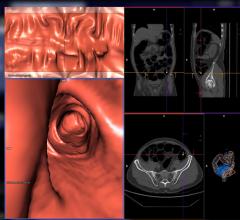July 14, 2008 - The American College of Radiology�s (ACR) CT colonography guidelines recommend that polyps ≤ 5mm in size not be reported on CT colonography by applying them to an endoscopic database that collected information about polyps that had been removed and processed, according to a study presented at Digestive Disease Week 2008 (DDW).
Douglas K. Rex, M.D., FASGE, chancellors professor of medicine, Indiana University School of Medicine and director of endoscopy at Indiana University Hospital, presented the study, "American College of Radiology (ACR) Recommendations for CT Colonography (CTC) Interpretation: Implications for Resection of High Risk Adenoma Findings," during DDW.
The guidelines also recommend that patients with one or two polyps 6 to 9 mm in size and no larger polyps can have repeat CT colonography in three years rather than prompt polypectomy. The database included information for 10,780 polyps removed from 5,079 patients (among 10,034 colonoscopies) over a five-year interval.
The report concluded that if CT colonography rather than colonoscopy had been used in this population, and assuming 100 percent sensitivity of CT colonography for polyps ≥ 6 mm and ACR interpretation recommendations, then 29 percent of all patients and 30 percent of patients over age 50 with high-risk adenoma findings would have been interpreted as normal. High risk adenoma findings were defined according to current post-polypectomy surveillance guidelines as any adenoma 1 cm or larger in size, any adenoma with high grade dysplasia or villous elements, or patients with three or more adenomas of any size. An additional 18 percent of both groups could have had polypectomy delayed for at least three years.
For more information: www.ddw.org


 February 06, 2024
February 06, 2024 









